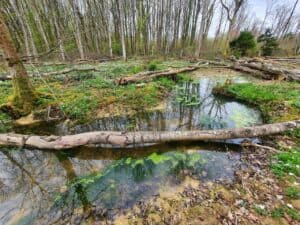Restoring natural processes
“So we said, ‘Yes! Just make it wetter!’” Even though landowner Mike Bax has told the story of how the South East Rivers Trust delivered a project on their farm many times now, I still get excited every time he does.
The wetland restoration in Streetend Wood, Ashford, which was delivered as part of our PROWATER project to create resilience to climate change, has been in place for less than a year.
The work has restored a headwater wetland by regrading an over-deepened channel, helping to slow the flow of water downstream and retain it on site by spilling it out into its floodplain more.
This means that water reaches the main river more slowly, with benefits to flood risk and water resources further down, and the wildlife on site.
So far, we have taken members of the farmer cluster, Kent County Council, water companies, the Environment Agency, Natural England and many more to the site to tell the story of how we are trying to restore natural processes and slow flows in rivers.
Overall, we couldn’t be happier with the responses we’ve had (“It’s a triumph!” has been my favourite feedback so far).
Not all landowners want, or can afford, to do this. We have been very lucky to work with landowners such as Mike and his wife Jan, who have been nothing but supportive and open to ideas, without any financial incentive.
However, farmers have many competing pressures placed on them: prices of inputs, such as fuel to drive tractors, or seed; demands from retailers and consumers; the weather. You name it.

